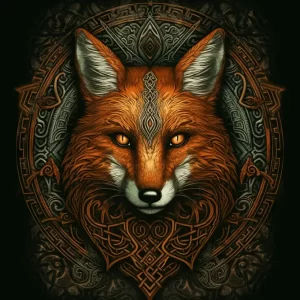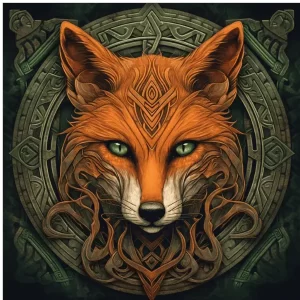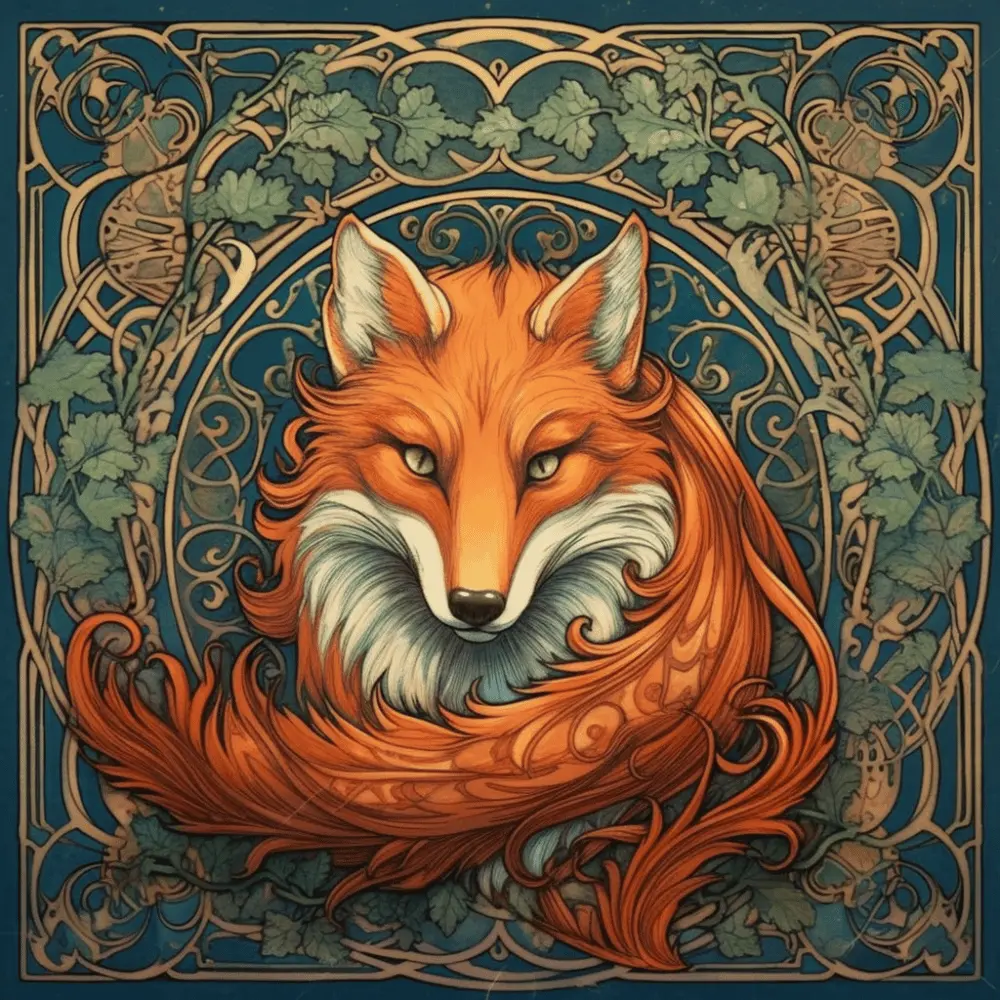Celtic mythology refers to the rich collection of myths, legends, and folklore that originated from the ancient Celtic people who inhabited the British Isles, Ireland, and parts of Western Europe. These stories were passed down orally and later transcribed by medieval Christian scholars, with the most famous collections including the Irish Mythological Cycle, the Ulster Cycle, and the Welsh Mabinogion. Celtic mythology is characterized by a pantheon of gods and goddesses, otherworldly realms, and an emphasis on the interconnectedness of humans, nature, and the supernatural.
Celtic Fox Mythology
Animals play a significant role in Celtic beliefs and folklore, as they were seen as embodiments of divine or supernatural powers. They were often considered sacred and held symbolic meanings, influencing Celtic art, rituals, and everyday life. Some animals, like the stag, the horse, and the salmon, were associated with specific deities or held powerful attributes like wisdom, strength, or fertility. These creatures played prominent roles in various myths and legends, often serving as guides, allies, or adversaries to the heroes of the tales.
The fox holds a special place in Celtic mythology due to its unique characteristics and behaviors. This elusive and intelligent animal has long been associated with cunning, adaptability, and the ability to navigate between the physical and spiritual realms. The fox was seen as a creature of liminality, a bridge between the world of humans and the supernatural, with a deep connection to the wild and untamed aspects of nature.

In many Celtic myths and legends, the fox is portrayed as a trickster figure, using its wit and guile to outsmart other animals and even humans. Foxes are often described as shape-shifters, taking on human or other forms to achieve their goals. This ability to transform and adapt is seen as a metaphor for the ever-changing nature of life, making the fox a powerful symbol of transformation and resilience in the face of adversity.
The fox’s role in Celtic mythology is not limited to stories and symbolism. Its image can be found in Celtic art and artifacts, such as intricate knotwork designs and illuminated manuscripts like the Book of Kells. Foxes were also present in Celtic rituals and ceremonies, with their participation in events such as Samhain celebrations and rites of passage like fox hunting.
Foxes in Celtic Deities and Heroic Tales
Cernunnos, the horned god of nature and wild animals, is often associated with foxes. As a symbol of nature’s untamed aspects, Cernunnos is typically depicted with antlers, surrounded by various animals, including foxes. In Celtic art and literature, foxes are sometimes shown alongside Cernunnos, emphasizing their connection to the natural world and his role as their protector and guardian.
Foxes also eature in several tales of shape-shifting and trickery in Celtic folklore. One such story is that of Llwyd ap Cil Coed, a magician who used his powers to avenge the death of his friend by transforming himself into a fox. In this form, Llwyd tricked and tormented the king responsible for his friend’s death, ultimately causing the king’s downfall. Another tale involving foxes is the story of Fionn mac Cumhaill, a legendary Irish hero. In this story, a fox uses its cunning to help Fionn escape from a trap set by his enemies. The fox’s intelligence and ability to outwit its adversaries are key components of its role in this story.
The fox can also serve as a guide and ally in hero’s journeys, as seen in the Welsh tale of Culhwch and Olwen. In this story, the hero Culhwch embarks on a quest to win the hand of Olwen, the daughter of a giant. Throughout his journey, Culhwch encounters various challenges and must complete seemingly impossible tasks. At one point, Culhwch and his companions are guided by a fox, which leads them through a dangerous forest to the lair of the fearsome giant. The fox’s role as a guide in this tale highlights its symbolic association with liminality and the ability to navigate between the human and spirit worlds.
Was there a Celtic Fox Goddess?
Sionna sought out the Well of Wisdom (also known as the Connla’s Well or the Well of Segais), believed to be a source of immeasurable knowledge and enlightenment. According to the legend, Sionna tried to gain the wisdom of the well, but the waters of the well rose up, swept her away, and created the River Shannon. This story underscores Sionna as a figure of wisdom and knowledge, as well as transformation, due to her symbolic journey and transformation into a river.
Foxes, on the other hand, are often associated with intelligence, cunning, and adaptability in Celtic fox mythology. They are frequently depicted as guides or messengers between the human world and the spirit world. However, this is a broad symbolism of foxes in Celtic culture and not specifically linked to the goddess Sionna.
Despite the lack of direct association between Sionna and foxes in canonical Celtic fox mythology, the modern interpretations of ancient mythologies often intermingle various elements to create new narratives and symbolisms. In that context, one could conceive of a connection between Sionna and foxes.
For instance, considering Sionna’s pursuit of wisdom and the fox’s symbolic association with intelligence and cunning, one could imagine the fox as a guide or companion to Sionna in her quest for wisdom. This would symbolize the use of intelligence and adaptability in the pursuit of knowledge, which aligns with the characteristics of both the goddess and the animal.
The Fox in Celtic Art and Rituals
Foxes are frequently depicted in Celtic art, showcasing their importance within the culture. One such example can be found in Celtic knotwork, an intricate form of decorative art that often features animals, including foxes. The presence of foxes in these elaborate designs highlights their symbolic significance and their role in Celtic mythology.
Another prominent example of fox imagery in Celtic art is the Book of Kells, a 9th-century illuminated manuscript considered one of the most important artifacts of Celtic Christianity. The Book of Kells contains numerous illustrations of animals, with foxes appearing in several instances. Their inclusion in this sacred text underlines the connection between the fox and spiritual themes in Celtic culture.

Foxes also played a role in Celtic rituals and ceremonies. During Samhain, an ancient Celtic festival marking the end of the harvest season and the beginning of the darker half of the year, foxes were believed to possess heightened powers. As liminal creatures, they were thought to be able to move more freely between the world of the living and the world of the spirits during this time. In some regions, foxes were even considered to be messengers of the Otherworld, able to communicate with the spirits of the deceased.
Fox hunting was another activity in which the fox held a significant role. In Celtic society, it was considered a rite of passage for young warriors to participate in a ceremonial fox hunt. This ritual served as a test of their strength, skill, and courage, as well as a way to forge a connection with the natural world and the spirits that resided within it. The cunning and elusive nature of the fox made it a challenging quarry, and the successful capture of one was seen as a sign of the warrior’s prowess and favor with the gods.
Modern Interpretations and Influences
In contemporary Celtic art and design, the fox has become a popular motif, often featured in various forms such as paintings, sculptures, and jewelry. This resurgence of interest in the fox can be attributed to the enduring appeal of its symbolism and the desire to reconnect with Celtic heritage. Modern artists and craftspeople draw on the rich history and mythology surrounding the fox to create unique and captivating works of art that celebrate its significance in Celtic culture.
The continued relevance of fox symbolism in contemporary Celtic culture is evident in various aspects of daily life and popular culture. For instance, the fox’s attributes of cunning and intelligence are often invoked in modern storytelling and used as metaphors in discussions of strategy and problem-solving. The fox’s role as a liminal creature continues to resonate with people seeking to explore the mysteries of the Otherworld and the deeper aspects of their own spirituality. In this way, the symbolism of the fox remains an important part of contemporary Celtic identity and cultural expression.
Modern retellings and adaptations of Celtic fox mythology often feature the fox as a central character, reflecting its enduring appeal and importance in the tradition. Writers, filmmakers, and other creators draw on the rich history of Celtic fox mythology to craft new stories and reinterpretations that explore its many facets. These modern adaptations not only showcase the fox’s diverse roles in myth and folklore but also serve to introduce new audiences to the beauty and complexity of Celtic culture.

